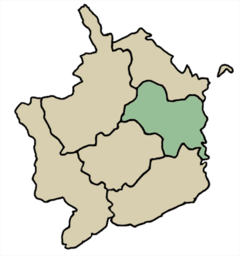Raglan Hundred: Difference between revisions
mNo edit summary |
No edit summary |
||
| Line 4: | Line 4: | ||
It is situated in the eastern part of the county, bounded on the north by the hundred of [[Skenfrith Hundred|Skenfrith]]; on the east by [[Gloucestershire]]; on the south by the hundred of [[Caldicot Hundred|Caldicot]]; on the south-west by the hundred of [[Usk Hundred|Usk]] and on the north-west by the hundred of [[Abergavenny Hundred|Abergavenny]]. | It is situated in the eastern part of the county, bounded on the north by the hundred of [[Skenfrith Hundred|Skenfrith]]; on the east by [[Gloucestershire]]; on the south by the hundred of [[Caldicot Hundred|Caldicot]]; on the south-west by the hundred of [[Usk Hundred|Usk]] and on the north-west by the hundred of [[Abergavenny Hundred|Abergavenny]]. | ||
It is the least populous of Monmouthshire's hundreds, with a population of 7, | This hundred is less mountainous than that of Usk to the south and watered with fewer streams than any hundred in the county. It is however a fine fertile district abounding in rich arable and pasture lands and pleasingly diversified with gentle elevations and depressions with occasional valleys and hills. It is the least populous of Monmouthshire's hundreds, with a population of 7,980. | ||
It contains the following ancient parishes: | It contains the following ancient parishes: | ||
| Line 20: | Line 20: | ||
*[[Llandogo]] | *[[Llandogo]] | ||
*[[Llangoven]] | *[[Llangoven]] | ||
*[[ | *[[Llangunnock]] | ||
*[[Llanishen, Monmouthshire|Llanishen]] | *[[Llanishen, Monmouthshire|Llanishen]] | ||
*[[Llanvihangel Tor-y-Mynydd]] | *[[Llanvihangel Tor-y-Mynydd]] | ||
| Line 30: | Line 30: | ||
*[[Penallt]] | *[[Penallt]] | ||
*[[Raglan]] | *[[Raglan]] | ||
*[[St Arvans]] (Porthcasseg) | |||
*[[Tintern|Tintern Parva]] | *[[Tintern|Tintern Parva]] | ||
*[[Tregare]] | *[[Tregare]] | ||
Revision as of 11:01, 18 December 2015

Raglan (also known as Ragland and Rhaglan)[1] is a Hundred of Monmouthshire.
It is situated in the eastern part of the county, bounded on the north by the hundred of Skenfrith; on the east by Gloucestershire; on the south by the hundred of Caldicot; on the south-west by the hundred of Usk and on the north-west by the hundred of Abergavenny.
This hundred is less mountainous than that of Usk to the south and watered with fewer streams than any hundred in the county. It is however a fine fertile district abounding in rich arable and pasture lands and pleasingly diversified with gentle elevations and depressions with occasional valleys and hills. It is the least populous of Monmouthshire's hundreds, with a population of 7,980.
It contains the following ancient parishes:
- Bettws Newydd
- Bryngwyn
- Chapel Hill
- Kilgwrrwg
- Cwmcarvan
- Devauden
- Dingestow
- Grace Dieu Park
- Llanarth (Clytha hamlet)
- Llandenny
- Llandogo
- Llangoven
- Llangunnock
- Llanishen
- Llanvihangel Tor-y-Mynydd
- Llansoy
- Llanvihangel Ystern Llewern (south of the Trothy)
- Mitchel Troy
- Penrhos
- Pen y Clawdd
- Penallt
- Raglan
- St Arvans (Porthcasseg)
- Tintern Parva
- Tregare
- Trellech (including Trelleck Grange)
- Wolvesnewton
References
- ↑ Vision of Britain - Rhaglan hundred (boundaries)
| Hundreds of Monmouthshire |
|---|
|
Abergavenny • Caldicot • Raglan • Skenfrith • Usk • Wentloog |